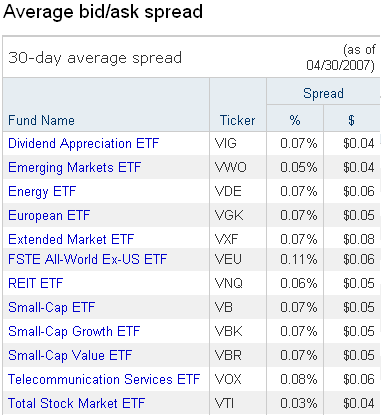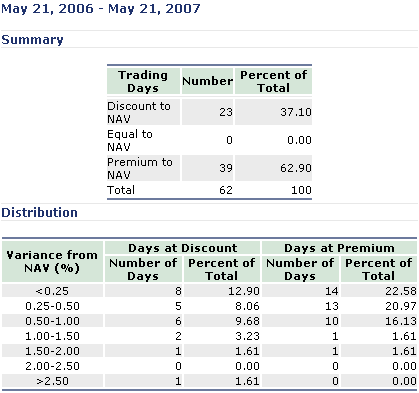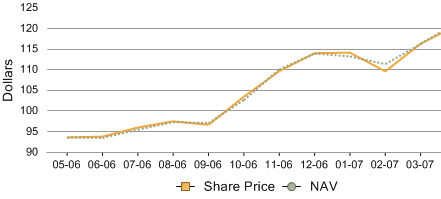Even though the expense ratio for an ETF may be slightly lower than a mutual fund, that doesn’t necessarily completely explain the cost differential between them. In addition to any commission costs, there are also the issues of bid/ask spreads and deviation from NAV. These are explained briefly below along with some useful tools to evaluate their impact.
Historical Bid/Ask Spread Values
Since ETFs are by definition traded on an open exchange, there can be differences between what people are currently willing to pay (the “bid” price), and what people are willing to sell at (the “ask” price). Even if you assume the ETF is priced correctly at it’s inherent value, this bid/ask spread means you will be overpaying a bit when you buy, and losing a bit when you sell. It can be thought of as slight purchase fee and redemption fee. (This also holds true when you trade individual stocks!) Mutual funds, on the other and, always trade at net asset value.
Some people try to avoid getting a “bad fill” for their trade by doing a limit order between the bid and ask instead of a market order, but limit orders carry the risk of non-execution. If the share price goes up, you’ve missed out and must submit another order anyways.
Many of the low-cost ETFs I am interested in are from Vanguard, and thankfully they have compiled a list of the average bid/ask spreads over the last 30 days for their entire ETF line-up. Here’s a sampling:

As you can see, the spread can be as high as 0.11% for some ETFs, but most are in the range of 0.05%. It is usually considered that you lose half of the bid/ask spread both when you buy and when you sell. This ~0.03% loss in and out shouldn’t be much of a factor if you buy-and-hold, but can add up if you trade often enough.
Premium or Discounts to Net Asset Value (NAV)
NAV is simply the value of the shares of the mutual fund minus any liabilities like expense ratio. A mutual fund always trades once a day, exactly at its NAV. However, again since an ETF is traded openly you don’t necessarily pay NAV. Now, it won’t deviate very much, as otherwise people can arbitrage profit, but it can still vary enough considering the slim expense ratio differences we’re talking about.
Many ETFs are traded on the American Stock Exchange (AMEX), and their site Amex.com is a good source of data about historical prices vs. NAV. Run a quote, and then look under Product Information > Premium/Discount. Here are the results for EEM:

You can also see a graphical representation at ETFConnect:

For many domestic ETFs the deviation from NAV is very slim, and many times likelihood of premium or discount is pretty equal. But for international ETFs like the charts above, there seems to be a much greater chance of significant deviation. I have read some speculation that this is due to the time difference of the markets closing, but nothing concrete. ETFConnect also gives others stats like daily average volume, breakdown by sectors, and historical returns in terms of both NAV and share price.
Please add your own handy sites in the comments…
 The Best Credit Card Bonus Offers – 2025
The Best Credit Card Bonus Offers – 2025 Big List of Free Stocks from Brokerage Apps
Big List of Free Stocks from Brokerage Apps Best Interest Rates on Cash - 2025
Best Interest Rates on Cash - 2025 Free Credit Scores x 3 + Free Credit Monitoring
Free Credit Scores x 3 + Free Credit Monitoring Best No Fee 0% APR Balance Transfer Offers
Best No Fee 0% APR Balance Transfer Offers Little-Known Cellular Data Plans That Can Save Big Money
Little-Known Cellular Data Plans That Can Save Big Money How To Haggle Your Cable or Direct TV Bill
How To Haggle Your Cable or Direct TV Bill Big List of Free Consumer Data Reports (Credit, Rent, Work)
Big List of Free Consumer Data Reports (Credit, Rent, Work)
Nice way of analysis for the ETF’s. I have linked this to my research at http://www.ongrowthtrack.com/2007/05/20/etf-investing/
Here’s a post on market timing. Maybe its my lack of understanding, but it seems like EFTs are just another way to snare the long term index fund crowd into active trading.
If you’re dollar cost averaging for a long term investment, so what?
according to bankrate.com’s Dr. Don: “…it makes more sense to pick one well-diversified fund than to diversify by picking several different funds. A hybrid fund that in a combination of stocks, bonds and cash will work for someone who wants to diversify across these asset classes….” i think i’m gonna do some research on “hybrid fund” also.
http://www.bankrate.com/brm/news/DrDon/20061127_mutual_fund_stock_a1.asp
Excellent post! I was just wondering about the difference between the two. I think I will go with the mutual fund because I can invest 100% of my funds and not have that couple bucks left over not doing anything.
Well, as I understand it, there are two benefits of ETFs for long-term holders. First, an ETF doesn’t have any minimums. Most mutual funds require minimum investments of $2000 – $3000 (sometimes even more). If you don’t have that much, you have to save in a savings account until you can accumulate that much. On the other hand, you can purchase an ETF for it’s share price, which is much lower that $3000.
Second, the expenses are often lower. For instance, with Vanguard, some of their mutual funds might have an expense ratio of 0.21%, but the equivalent EFT might have an expense ratio of only 0.11%.
There are other pros/cons of ETFs, but these are the two benefits I can think of for long term investors.
There are tax benefits to ETFs… They are a better choice for non-retirement accounts. If you think about it, they don’t have the inflows and outflows of a mutual fund which cause capital gains.
Actually, taking another look at it I realized that an ETF would be better. Here’s my situation:
Banking at Wells Fargo
$3,000 – not enough for free trades
Commissions: $20 for ETF, $35 for Funds
Using this calculator from a previous post: link
Costs come out to $56 to purchase ETF for 2 years and $94 for fund. Even with the bid/ask spread I still come out ahead (even though I should really switch my holdings to vanguard and buy funds without comissions, but oh well.)
Your site is a wealth of information!!!
I took finance classes for my MBA where we studied mutual funds and correlated their long-term returns with their expense ratio, and discovered a negative correlation exists. Big surprise. The higher the expenses the lower the returns. For actively managed funds, the management teams (contracted by the fund) take their fee right off the top, then they take off the other fees the fund charges. Studies have shown that the average mutual fund underperforms the market, which figures since they take their fee. You are better off in an ETF than picking a random fund, and think of the extra spread you pay at a discount brokerage as being paid off over time outperforming average funds.
An interesting way you can enter an ETF position (or any optionable stock) is to sell a put option at the price you are willing to pay. If it never drops to your price before expiration then you get the put money, and if it reaches its strike price you get the ETF for the strike of the put minus what you sold the put for (minus commissions). If you like the security at that price then why not?
“Some people try to avoid getting a “bad fill” for their trade by doing a limit order between the bid and ask instead of a market order, but limit orders carry the risk of non-execution. If the share price goes up, you’ve missed out and must submit another order anyways.”
I wish I had a quarter for every time this happened to me.
I’m glad I am not the only one!